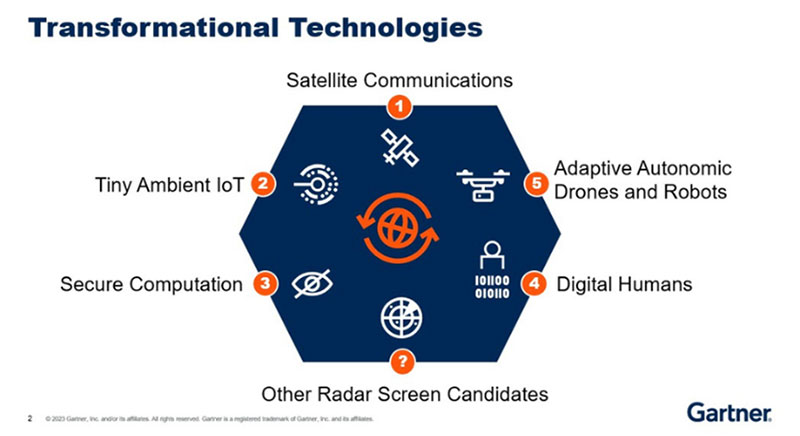Key Highlights
- Satellites will revolutionize communications to people and things.
- Tiny ambient IoT will sense and track anything at low cost without batteries.
- Secure computation will enable new digital ecosystems.
- Autonomic drones and robots will learn while they automate tasks.
- Digital humans will redefine assistants, robots and services.
Gartner, Inc. today highlighted five technologies that will transform the digital future of organizations. They include digital humans, satellite communications, tiny ambient IoT, secure computation and autonomic robots.
Nick Jones, Distinguished VP Analyst at Gartner said, “All five of these technologies are potentially transformational and should be investigated now due to their wide scope and ability to enable new business models or significant new capabilities (see figure 1).
“Everyone’s definition of disruptive is different, however, so evaluate them from your organization’s unique perspective and their potential impact. Then consider new business opportunities enabled by individual technologies, as well as combinations of them.”
Figure 1: Five Technologies That Will Transform Your Digital Future

Source: Gartner (September 2023)
- Satellite Communications
Increasing interest in low earth orbit (LEO) satellite communications is being driven by the democratization and commercialization of space. Low latency makes LEO an important technology for enterprises to revolutionize communications to people and things.
According to Gartner, LEO will deliver broadband with global coverage and low enough latency for a wide range of tasks; direct satellite connection for small IoT devices to provide affordable global coverage without involving SIMs, telco providers and roaming complications; and voice and data services from a satellite to an unmodified 4G smartphone to extend coverage to remote locations.
“The industry remains nascent, with a lot of evolution expected, so take a cautious approach to adopting LEO early as this is an emergent technology in a complex market,” said Jones.
- Tiny Ambient IoT
Tiny ambient IoT enables tagging, tracking and sensing of anything without the complexity or cost of battery-powered devices. The result is the ability to unobtrusively sense more information, about more things, in more ways, at a lower cost than in the past.
This will enable new ecosystems; new business models based on knowing the location or behavior of objects; smarter products with new behaviors; and a much lower cost of tracking and monitoring. Tiny ambient IoT will expand opportunities for a wide range of businesses, but Gartner recommends assessing potential social and regulatory issues before adoption.
- Secure Computation
Secure computation is becoming vitally important as things become increasingly connected and as ecosystems access more personal information. It enables data to be exploited without compromising privacy.
While many of the principles of secure computation are already established, implementation is challenging for reasons of cost, skills, performance and availability. To help overcome these, Gartner suggests emerging technologies such as optical accelerators will be important to enable deployment.
- Digital Humans
Digital humans are interactive, AI-driven representations that imitate some characteristics, personality, knowledge and mindset of a human. They range from physical (e.g. humanoid robots) to virtual (e.g. virtual pop stars); or human-driven (e.g. mimicking aspects of a human) to AI driven where they do not need to be human-like in all aspects (e.g. a digital twin or chatbot).
Despite their potential, digital humans pose many challenges, including unethical applications; inappropriate behavior; creation of bias and stereotypes; lack of regulation; risk of social backlash; varying cultural attitudes; and more. Gartner recommends assessing potential social and regulatory issues before adoption.
- Adaptive Autonomic Drones and Robots
Autonomic systems are self-managing physical or software systems, performing tasks that exhibit autonomy, learning and agency (sense of own personal purpose). Systems that learn and adapt autonomously will be essential if technologies like robots are scaled to achieve their full potential.
However, a multitude of challenges exist as it may not be obvious what a robot or AI system has learned or what it can (or cannot) do. Gartner recommends piloting them in complex and rapidly changing environments, where early adoption will deliver agility and performance benefits. Manage risk by analyzing the business, legal and ethical consequences.
ประเด็นสำคัญ
- ดาวเทียม (Satellites) จะปฏิวัติการสื่อสารของผู้คนและสิ่งต่าง ๆ
- อุปกรณ์ IoT โดยรอบขนาดจิ๋ว (Tiny Ambient IoT) จะตรวจจับและติดตามทุกสิ่งด้วยค่าใช้จ่ายต่ำและไม่ต้องใช้แบตเตอรี่
- การประมวลผลที่ปลอดภัย (Secure Computation) จะเปิดโลกใหม่ของระบบนิเวศดิจิทัล
- โดรนและหุ่นยนต์อัตโนมัติ (Autonomic Drones and Robots) จะทำงานและเรียนรู้ไปพร้อมกัน
- มนุษย์ดิจิทัล (Digital Humans) จะกำหนดนิยามใหม่ให้กับผู้ช่วย หุ่นยนต์และบริการต่าง ๆ
การ์ทเนอร์ เผย 5 เทคโนโลยีที่จะเปลี่ยนแปลงอนาคตดิจิทัลของภาคองค์กร ได้แก่ มนุษย์ดิจิทัล (Digital Human), การสื่อสารผ่านดาวเทียม (Satellite Communication), อุปกรณ์ IoT โดยรอบขนาดจิ๋ว (Tiny Ambient IoT), การประมวลผลที่ปลอดภัย (Secure Computation) และหุ่นยนต์อัตโนมัติ (Autonomic Robots)
นิค โจนส์ รองประธานฝ่ายวิจัยของการ์ทเนอร์ กล่าวว่า “เทคโนโลยีทั้งห้านี้มีศักยภาพในการเปลี่ยนโฉมขององค์กรธุรกิจได้และควรได้รับการตรวจสอบอย่างถี่ถ้วนในตอนนี้เลย เนื่องจากเทคโนโลยีเหล่านี้มีขอบเขตที่กว้างมากและมีความสามารถเปิดโมเดลธุรกิจใหม่ ๆ หรือ ความสามารถสำคัญ ๆ (ดูรูปที่ 1)
“คำจำกัดความคำว่า Disruptive ของแต่ละคนไม่เหมือนกัน ดังนั้นให้ประเมินจากมุมมองที่เป็นเอกลักษณ์ขององค์กรและผลกระทบที่อาจเกิดขึ้น จากนั้นให้พิจารณาถึงโอกาสทางธุรกิจใหม่ ๆ ที่เกิดจากเทคโนโลยีแต่ละอย่าง รวมถึงแนวทางการเชื่อมผสานเทคโนโลยีเหล่านี้เข้าด้วยกัน”
รูปที่ 1: 5 เทคโนโลยีสำคัญที่จะทรานส์ฟอร์มอนาคตดิจิทัลองค์กร

ที่มา: Gartner (กันยายน 2566)
- การสื่อสารผ่านดาวเทียม (Satellite Communications)
การสื่อสารผ่านดาวเทียมวงโคจรต่ำ (Low Earth Orbit หรือ LEO) ได้รับความสนใจเพิ่มขึ้น และกำลังได้รับแรงผลักดันจากการทำให้ห้วงอวกาศเป็นพื้นที่เสรี (Democratization of Space) และการใช้ห้วงอวกาศเป็นเชิงพาณิชย์ (Commercialization of Space) ด้วยประสิทธิภาพความเร็วในด้านการสื่อสาร (Low Latency) ทำให้ดาวเทียมวงโคจรต่ำ (LEO) เป็นเทคโนโลยีสำคัญขององค์กรในการปฏิวัติการสื่อสารกับผู้คนและสิ่งของต่าง ๆ
จากข้อมูลของการ์ทเนอร์ LEO จะให้บริการอินเทอร์เน็ตบรอดแบนด์ที่ครอบคลุมทั่วโลกและมีประสิทธิภาพรับ-ส่งสัญญาณรวดเร็วเพียงพอต่อการใช้งานที่หลากหลาย ซึ่งการเชื่อมต่อดาวเทียมโดยตรงสำหรับอุปกรณ์ IoT ขนาดเล็กให้ความครอบคลุมทั่วโลกในราคาไม่แพง โดยไม่ต้องใช้ซิม หรือผู้ให้บริการโทรคมนาคม และการโรมมิ่งที่ยุ่งยาก รวมถึงบริการด้านเสียงและข้อมูลจากดาวเทียมไปยังสมาร์ทโฟน 4G ที่ไม่มีการดัดแปลงเพื่อขยายความครอบคลุมไปยังสถานที่ห่างไกล
“อุตสาหกรรมนี้ยังอยู่ในขั้นเริ่มต้น คาดว่าจะมีวิวัฒนาการอีกมาก ดังนั้นควรระมัดระวังในการนำ LEO มาใช้ตั้งแต่เนิ่น ๆ เนื่องจากเป็นเทคโนโลยีที่เกิดขึ้นใหม่ในตลาดที่ซับซ้อน” โจนส์ กล่าวเพิ่มเติม
- Tiny Ambient IoT
IoT โดยรอบขนาดจิ๋ว ช่วยให้สามารถติดแท็ก ติดตาม และตรวจจับทุกสิ่งได้โดยไม่ต้องใช้ความซับซ้อนหรือต้นทุนของอุปกรณ์ที่ใช้พลังงานจากแบตเตอรี่ ผลลัพธ์ที่ได้คือความสามารถในการรับรู้ข้อมูลเพิ่มเติม เกี่ยวกับสิ่งต่าง ๆ มากขึ้น ในรูปแบบหลากหลายมากขึ้นด้วยต้นทุนที่ต่ำกว่าในอดีต
สิ่งนี้จะทำให้เกิดระบบนิเวศใหม่ โมเดลธุรกิจใหม่โดยอาศัยการรู้ตำแหน่งหรือพฤติกรรมของวัตถุ ด้วยผลิตภัณฑ์ที่ชาญฉลาดยิ่งขึ้นพร้อมพฤติกรรมใหม่ และค่าใช้จ่ายในการติดตามที่ต่ำกว่ามาก IoT ขนาดเล็กจะขยายโอกาสให้กับธุรกิจที่หลากหลาย แต่การ์ทเนอร์แนะนำให้ประเมินปัญหาทางสังคมและกฎระเบียบที่อาจเกิดขึ้นก่อนนำไปใช้
- การประมวลผลที่ปลอดภัย (Secure Computation)
การประมวลผลที่ปลอดภัยกำลังมีความสำคัญอย่างยิ่งเมื่อสิ่งต่าง ๆ เชื่อมโยงกันมากขึ้นและในขณะที่ระบบนิเวศเข้าถึงข้อมูลส่วนบุคคลมากขึ้นทำให้สามารถใช้ประโยชน์จากข้อมูลได้โดยไม่กระทบต่อความเป็นส่วนตัว
แม้ว่าหลักการหลายประการของการประมวลผลที่ปลอดภัยได้ถูกกำหนดไว้แล้ว แต่การนำไปใช้งานก็เป็นเรื่องที่ท้าทายด้วยเหตุผลด้านต้นทุน ทักษะ ประสิทธิภาพ และความพร้อมใช้งาน การ์ทเนอร์แนะนำว่าเทคโนโลยีเกิดใหม่ เช่น Optical Accelerators จะมีความสำคัญต่อการเปิดใช้งาน
- มนุษย์ดิจิทัล(Digital Humans)
Digital Humans เป็นการนำเสนอเชิงโต้ตอบที่ขับเคลื่อนด้วย AI เลียนแบบลักษณะเฉพาะ บุคลิกภาพ ความรู้ และกรอบความคิดของมนุษย์ ตั้งแต่การเลียนแบบทางกายภาพ (เช่น หุ่นยนต์ฮิวแมนนอยด์) ไปจนถึงเลียนแบบเสมือนจริง (เช่น ป๊อปสตาร์เสมือนจริง) หรือการเลียนแบบที่ควบคุมโดยมนุษย์ (เช่น การเลียนแบบพฤติกรรมมนุษย์) ไปสู่การควบคุมด้วย AI โดยที่ไม่จำเป็นต้องเป็นเหมือนมนุษย์ทุกด้าน (เช่น Digital Twin หรือ Chatbot)
แม้มนุษย์ดิจิทัลจะมีศักยภาพ แต่กลับเผชิญกับความท้าทายมากมาย รวมถึงการใช้งานที่ผิดจรรยาบรรณ พฤติกรรมที่ไม่เหมาะสม การสร้างอคติและแบบแผนที่ขาดกฎระเบียบ มีความเสี่ยงต่อการขับเคลื่อนทางสังคม ทัศนคติทางวัฒนธรรมที่แตกต่างกัน และอื่น ๆ การ์ทเนอร์แนะนำให้ประเมินประเด็นทางสังคมและกฎระเบียบที่อาจเกิดขึ้นก่อนนำไปใช้
- โดรนและหุ่นยนต์อัตโนมัติแบบปรับเปลี่ยนได้(Adaptive Autonomic Drones and Robots)
ระบบอัตโนมัติคือระบบกายภาพหรือซอฟต์แวร์ที่สามารถจัดการตนเอง โดยสามารถปฏิบัติงาน เรียนรู้ และเข้าใจเป้าหมายได้อย่างมีอิสระ ระบบเรียนรู้และระบบปรับตัวอัตโนมัติจะมีความสำคัญหากเทคโนโลยีเช่นหุ่นยนต์ได้รับการสเกลเพื่อให้บรรลุศักยภาพสูงสุด
อย่างไรก็ตาม มีความท้าทายมากมายเกิดขึ้น เนื่องจากยังมีความไม่ชัดเจนว่า หุ่นยนต์หรือระบบ AI ได้เรียนรู้อะไร หรือสิ่งที่หุ่นยนต์สามารถทำได้ (หรือไม่สามารถทำได้) การ์ทเนอร์แนะนำให้เริ่มทดสอบสภาพแวดล้อมที่ซับซ้อนและเปลี่ยนแปลงอย่างรวดเร็ว ซึ่งการนำไปใช้ตั้งแต่เนิ่น ๆ จะมอบความคล่องตัวและเป็นประโยชน์ในด้านประสิทธิภาพ แต่ต้องรับมือกับความเสี่ยงที่เกิดจากการวิเคราะห์ธุรกิจ ทั้งทางกฎหมายและจริยธรรม

